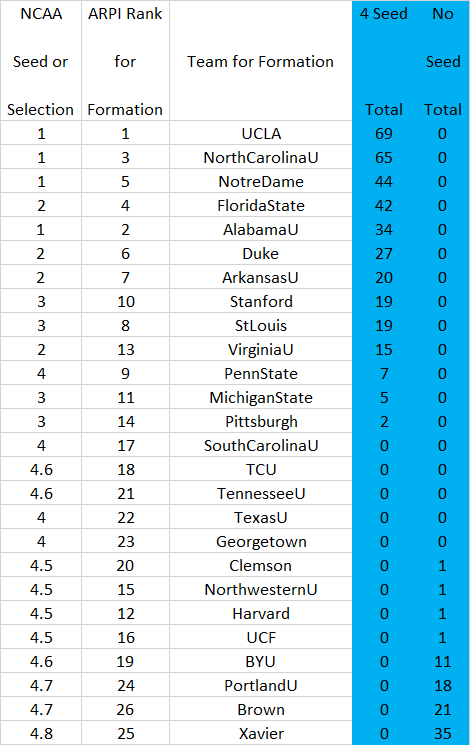Below are tables showing simulated seed and at large selection candidate groups based on the actual results of games played through October 30 and simulated results of games not yet played.
For the candidate groups for seeds and at large selections, each table shows how many historic patterns each team meets indicating that the team will or will not get a positive decision from the Committee. In addition, I have indicated potential Committee decisions based on the patterns. If there are positions open for which there are not clear seeds or at large selections, an additional table shows a potential basis for filling those positions. Each set of tables simply reflects Committee decision patterns from 2007 to the present.
In addition to the four pods of #1 through #4 seeds, the Committee this year will create four pods of #5 through #8 seeds. The Committee has not done this before, so there are no directly applicable decision patterns to apply to the data. Since 2010, however, the Committee each year has had 16 first round games involving unseeded opponents. In those games, it appears the Committee has awarded home field to the team it concluded had performed better over the course of the season. Since this is as good as we will get until the Committee actually has seeded four new pods, I have used the Committee patterns for selecting home teams for those games as a basis for projecting teams to be in the #17 through #32 seed range that will fill the four new pods. I will not go into detail here, but will say that for the new seed pods I have used a method similar to what I historically have used for projecting Committee seeds and at large selections. In general, my caution is to take these projections with a very big grain of salt.
To be clear: All of the seeds and at large selections shown below are based on the assumption that all teams, through the end of the season, will perform in accord with their current ARPI ratings as adjusted for game locations. In addition, they are based on the assumption the Committee will follow its historic patterns, which may not happen.
Reminder: From among the teams that are not automatic qualifiers, the Committee will pick 33 at large participants.
#1 Seeds (Candidate Pool #1 through #7)
Based on the table, Stanford, Pittsburgh, and Michigan State are #3 seeds. St Louis, Penn State, and South Carolina are candidates for the last #3 seed.
Using a method similar to what you see above, here are the new seed pods, designated 4.5 through 4.8:
At Large Selections (Candidate Pool #1 through #57)
In the table, teams with tiebreaker ranks #1 through #10 get at large selections. Teams 11 through 14 do not. In the long table above this one, the teams getting the 10 at large selections are marked #6 and the candidates not getting at large selections are #7.












No comments:
Post a Comment